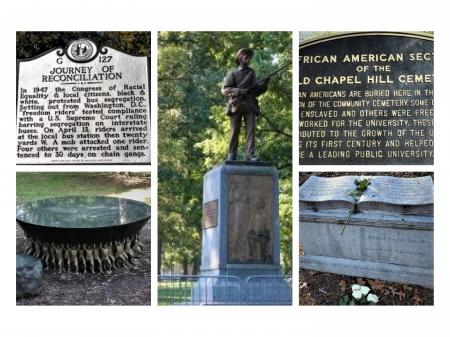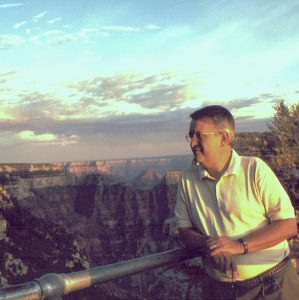
On one visit to Chapel Hill, NC, home to my beloved Tar Heels, I discovered five monuments to its history (pictured above). I believe that they tell an history that is both local and national in its narrative. These monuments, and those like them that are scattered across the communities of our country are part of the history that should be taught; part of the history that critics of CRT do not want told.
Silent Sam: Erecting a Confederate monument at the University became a goal of the North Carolina chapter of the United Daughters of the Confederacy . Funding from UNC alumni, the UDC and the university,paid for the sculpture which was unveiled on June 2, 1913. Local industrialist and UNC Trustee Julian Carr gave a speech espousing white supremacy and Governor Locke Craig,UNC President Francis Venable and members of the UDCpraised the sacrifices made by students who volunteered to fight for the Confederacy. (Wikipedia)
Beginning in the 1960’s the statue became a focal point for civil rights protests and most recently BLM rallies. Finally, Sam was removed; gone but not forgotten. In an effort to appease the Lost Cause, the University’s Board proposed a five million dollar (plus $800,000 yearly maintenance) “History and Education Center” to house Sam (plus $800,000 yearly maintenance). This and another attempt to resurrect Sam were rejected and, for now, he lies sequestered somewhere.
Freedom Riders: The plaque found on Columbia Street tells of the beating, arrest, trial, and sentencing to four months hard labor of four Freedom Riders (two Black men who who refused to give up their seats and two white men who supported them).
African American Cemetery: Across the street from the famous Carmichael Auditorium, home to the Heel’s basketball team for many years, is a small cemetery. Originally set aside for students who died on campus, it became the final resting place for the prominent citizens of the town. However, two sections were for the Black servants and slaves who passed away. The cemetery is now just an open field, any marker which may have been present long decayed. “It’s sort of a sad story that we’re looking at people who’ve been completely forgotten, both in life and now in death,” Cheri Szcodronski, head of the organization who cares for the plot. “Our hearts sort of tell us that we should mark them with stones, but we also don’t want to erase the story of segregation and slavery and Jim Crow and the things that lead to the landscape looking the way that it does now.”
Dean Smith’s Final Resting Place: Just a short walk from the unmarked graves of the African American section, lies the headstone of basketball coach Dean Smith. Smith, a Hall of Fame coach, is also noted for his views on social justice. Dean brought the first Black player into the ACC basketball league and was outspoken against capital punishment. In 1959, Dean accompanied his pastor and a Black seminary student to The Pines, a segregated club. Pastor Seymour felt that because of Dean’s presence they would be seated, and they were. Folk legend likes to say that Dean helped integrate the Pines, but it was not until several more years passed that another POC was seated in that restaurant.
Unnamed Founders’ Table: A small and unassuming memorial, this depicts three hundred African Americans raising their arms to support the table above them, a symbol of those Blacks from every walk of American life who worked to build the University but seldom had a seat at the table.
A sixth monument does not exist, but it should be built. It is a monument to the narrow mindedness of the university’s board of trustees who took the highly unusual step of failing to approve the journalism department’s recommendation of tenure for Nikole Hannah-Jones, a Pulitzer Prize-winning writer for The New York Times Magazine. She was being appointed to the Knight Chair in Race and Investigative Journalism at U.N.C.’s Hussman School of Journalism and Media. This was seen as a way that the BOC could exercise control over the creator of the 1619 Project. She has now taken her talent to Howard, an HBU. As Mama Gump said….
